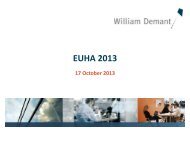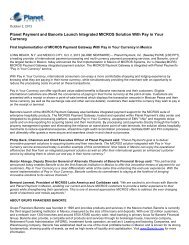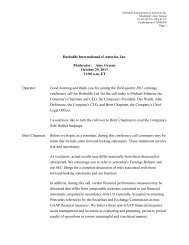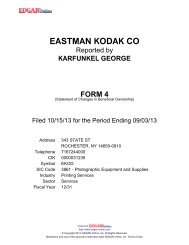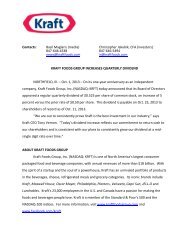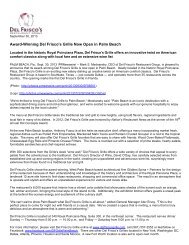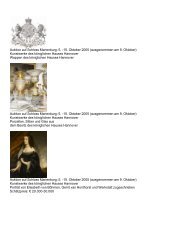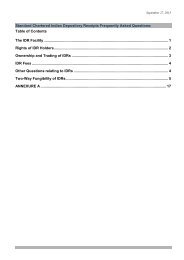matson, inc. form def 14a - Shareholder.com
matson, inc. form def 14a - Shareholder.com
matson, inc. form def 14a - Shareholder.com
You also want an ePaper? Increase the reach of your titles
YUMPU automatically turns print PDFs into web optimized ePapers that Google loves.
American Savings Bank (i) has a 10.8 percent participation in A&B’s $225 million revolving credit and term loan agreement, of which, in 2009, the largest aggregate amount of<br />
pr<strong>inc</strong>ipal outstanding was $60,000,000; $70,000,000 and $110,962 were paid in pr<strong>inc</strong>ipal and interest, respectively; and $30,000,000 was outstanding on February 19, 2010, with interest payable<br />
on a sliding scale at rates between 0.225 percent to 0.475 percent (based on A&B’s current credit rating) plus LIBOR, (ii) has a 10.8 percent participation in Matson’s $100 million revolving<br />
credit and term loan agreement (such loan being linked to the $225 million facility described in (i) above), of which, in 2009, the largest aggregate amount of pr<strong>inc</strong>ipal outstanding was<br />
$70,000,000; $106,000,000 and $61,673 were paid in pr<strong>inc</strong>ipal and interest, respectively; and $17,000,000 was outstanding on February 19, 2010, with interest payable on a sliding scale at rates<br />
between 0.225 percent to 0.475 percent (based on Matson’s current credit rating) plus LIBOR, (iii) is a <strong>com</strong>mercial tenant in certain property owned by an A&B subsidiary, under a lease with a<br />
term that expires in December 2017, with aggregate gross rent in 2009 of $67,994, and aggregate net rent from and after January 1, 2010 of $428,622, and (iv) is a holdover lessee in A&B’s<br />
Mililani Shopping Center, which was sold by A&B in January 2010, with a month-to-month lease for a net monthly rent of $9,720, and is a holdover lessee and licensee in A&B’s Maui Mall<br />
Shopping Center, with a month-to-month lease and a month-to-month license for a net monthly rent of $800 and $1,874 per month, respectively.<br />
In 2009, an A&B division sold electricity that it had produced to Maui Electric Company, Inc., an HEI subsidiary, in the amount of approximately $9,275,000.<br />
Ms. Lau’s spouse is the President and Chief Executive Officer of Finance Enterprises, Ltd., a Hawaii-based financial institution. Subsidiaries of Finance Enterprises have two<br />
<strong>com</strong>mercial leases with a subsidiary of A&B, with terms expiring in September 2010 and November 2012, with aggregate gross rents in 2009 of $186,620, and aggregate net rents from and after<br />
January 1, 2010 of $261,812.<br />
The brother of Matthew J. Cox, President of Matson, is an officer in a <strong>com</strong>pany from which Matson leases transportation equipment. The aggregate amount paid under the leases in 2009<br />
was $1,834,439, and the remaining aggregate rental obligations, which expire in July and August 2011, are $1,463,868.<br />
Code of Ethics . A&B has adopted a Code of Ethics (the “Code”) that applies to the CEO, Chief Financial Officer (“CFO”) and Controller. A copy of the Code, along with copies of<br />
Codes of Conduct applicable to all directors, officers and employees of A&B, is posted on the corporate governance page of A&B’s corporate website, www.alexanderbaldwin.<strong>com</strong> . A&B<br />
intends to satisfy any disclosure requirements under Item 5.05 of Form 8-K regarding an amendment to, or a waiver from, a provision of the Code by posting such in<strong>form</strong>ation on its website.<br />
Code of Conduct . A&B has adopted a Code of Conduct, which is posted on the corporate governance page of A&B’s corporate website, www.alexanderbaldwin.<strong>com</strong> .<br />
EXECUTIVE COMPENSATION<br />
Compensation Discussion and Analysis (“CD&A”)<br />
The CD&A addresses A&B’s <strong>com</strong>pensation practices for 2009 for the six executive officers (<strong>inc</strong>ludes an officer who retired before December 31, 2009) named in the Summary<br />
Compensation Table below (collectively, the “Named Executive Officers” or “NEOs”).<br />
Compensation Overview<br />
Compensation Philosophy and Objectives. The Company seeks to align its objectives with shareholder interests through a <strong>com</strong>pensation program that attracts, motivates and retains<br />
outstanding executives, and rewards outstanding per<strong>form</strong>ance. To achieve this, the Company uses the following pay elements (described in further detail under “Pay Elements” below):<br />
Target Compensation Percentiles. To achieve the Company’s <strong>com</strong>pensation philosophy, the Compensation Committee has set target <strong>com</strong>pensation percentiles as follows:<br />
Actual <strong>com</strong>pensation may be higher or lower, depending on Company and individual per<strong>form</strong>ance.<br />
As a result of the economic environment, the Company’s <strong>com</strong>pensation philosophy for 2009 was to target the 50 th percentile of <strong>com</strong>petitive market data. The Company has a unique set<br />
of businesses and geographies in which it <strong>com</strong>petes. Attracting and retaining top talent in these businesses and geographic segments, particularly Hawaii and the San Francisco Bay Area, where<br />
the high cost of living and <strong>com</strong>petitive job market normally challenge the Company’s staffing efforts, remain difficult. In 2009, a <strong>com</strong>petitive assessment of salary, target annual and target longterm<br />
<strong>inc</strong>entives for Company executives was conducted and found that salaries are at about the 50 th percentile, target total cash <strong>com</strong>pensation approximates the 35 th percentile and total direct<br />
<strong>com</strong>pensation is at about the 45 th percentile of <strong>com</strong>petitive practices. While this is below the established <strong>com</strong>pensation philosophy, the Committee believes these levels are appropriate at this<br />
time given the economic conditions.<br />
Combination of Pay Elements . The Company’s target <strong>com</strong>pensation percentiles, described above, result in a program that places greater emphasis on per<strong>form</strong>ance-based <strong>com</strong>pensation,<br />
while at the same time focuses on long-term talent retention. The Committee believes that this is consistent with one of its key <strong>com</strong>pensation objectives, which is to align management interests<br />
with shareholder interests. For 2009, the Compensation Committee placed about the same emphasis on long-term <strong>inc</strong>entive <strong>com</strong>pensation as <strong>com</strong>petitive practice, as shown in the following<br />
table. This occurred because the Committee reduced target <strong>inc</strong>entive plan opportunities for the year. Normally, the Committee’s intent is to put more emphasis on long-term <strong>inc</strong>entive<br />
<strong>com</strong>pensation than <strong>com</strong>petitive practice to keep executives focused on longer-term results. The Committee believes this philosophy provides the greatest benefit to shareholders.<br />
Percentage of Target Total Direct Compensation Provided by Each Pay Element for 2009<br />
NEO A&B NEOs Competitive<br />
Salary Annual<br />
Long-Term<br />
Salary Annual<br />
Long-Term<br />
Incentives *<br />
Incentives<br />
Incentives<br />
Incentives<br />
Mr. Doane 24% 12% 64% 23% 22% 55%<br />
Mr. Kuriyama 29% 13% 58% 34% 22% 44%<br />
Mr. Benjamin 39% 18% 43% 35% 21% 44%<br />
Mr. Andrasick 32% 13% 55% ** ** **<br />
Mr. Cox 40% 18% 42% 34% 23% 43%<br />
Mr. Buelsing 47% 12% 41% 40% 24% 36%<br />
* Reflects a 25% to 50% reduction in normal target award opportunities for the 2009 annual cash <strong>inc</strong>entive plan (as further described in the “Pay Elements” section).<br />
** Mr. Andrasick retired on August 31, 2009. Due to the uniqueness of his role during the transition of his duties and responsibilities, his job could not be <strong>com</strong>petitively evaluated. Mr.<br />
Andrasick’s <strong>com</strong>pensation between January 1, 2009 and August 31, 2009 was based on the executive transition agreement described further in the section entitled “Employment<br />
Agreements” (the “Executive Transition Agreement”).<br />
of pay.<br />
• Salary,<br />
• Annual cash <strong>inc</strong>entives,<br />
• Equity-based <strong>inc</strong>entives,<br />
• Health and welfare benefits,<br />
• Retirement benefits,<br />
• Severance Plan and Change in Control agreements, and<br />
• Executive perquisites.<br />
• Cash <strong>com</strong>pensation at or about the 50 th percentile of <strong>com</strong>petitive survey data (described in detail under “The Role of Survey Benchmarking”).<br />
• Total direct <strong>com</strong>pensation (salary, annual <strong>inc</strong>entives at target and long-term <strong>inc</strong>entives) between the 50 th and 60 th percentile.<br />
• Total <strong>com</strong>pensation (total direct <strong>com</strong>pensation, plus health and welfare benefits, retirement benefits and perquisites) between the 50 th and 60 th percentile.<br />
The Compensation Committee does not use specific <strong>form</strong>ulas to determine the mix of pay elements, or the allocation between cash and non-cash <strong>com</strong>pensation or among non-cash <strong>form</strong>s<br />
Review of Total Compensation. As part of determining total <strong>com</strong>pensation, the Compensation Committee reviews:<br />
• A summary of the value of all <strong>com</strong>pensation elements, both direct and non-direct, provided to the executive during the year,



